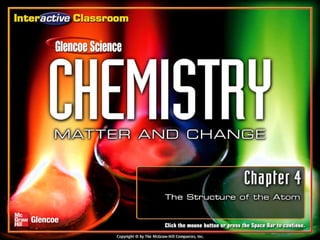Cmc chapter 04
•Als PPT, PDF herunterladen•
7 gefällt mir•2,513 views
Melden
Teilen
Melden
Teilen

Empfohlen
Empfohlen
Weitere ähnliche Inhalte
Was ist angesagt?
Was ist angesagt? (20)
Andere mochten auch
Andere mochten auch (20)
Ähnlich wie Cmc chapter 04
Ähnlich wie Cmc chapter 04 (20)
Mehr von Jane Hamze
Mehr von Jane Hamze (12)
Kürzlich hochgeladen
This presentation was provided by William Mattingly of the Smithsonian Institution, during the third segment of the NISO training series "AI & Prompt Design." Session Three: Beginning Conversations, was held on April 18, 2024.Mattingly "AI & Prompt Design: The Basics of Prompt Design"

Mattingly "AI & Prompt Design: The Basics of Prompt Design"National Information Standards Organization (NISO)
God is a creative God Gen 1:1. All that He created was “good”, could also be translated “beautiful”. God created man in His own image Gen 1:27. Maths helps us discover the beauty that God has created in His world and, in turn, create beautiful designs to serve and enrich the lives of others.
Explore beautiful and ugly buildings. Mathematics helps us create beautiful d...

Explore beautiful and ugly buildings. Mathematics helps us create beautiful d...christianmathematics
Kürzlich hochgeladen (20)
Call Girls in Dwarka Mor Delhi Contact Us 9654467111

Call Girls in Dwarka Mor Delhi Contact Us 9654467111
IGNOU MSCCFT and PGDCFT Exam Question Pattern: MCFT003 Counselling and Family...

IGNOU MSCCFT and PGDCFT Exam Question Pattern: MCFT003 Counselling and Family...
Z Score,T Score, Percential Rank and Box Plot Graph

Z Score,T Score, Percential Rank and Box Plot Graph
Mattingly "AI & Prompt Design: The Basics of Prompt Design"

Mattingly "AI & Prompt Design: The Basics of Prompt Design"
Measures of Central Tendency: Mean, Median and Mode

Measures of Central Tendency: Mean, Median and Mode
A Critique of the Proposed National Education Policy Reform

A Critique of the Proposed National Education Policy Reform
Measures of Dispersion and Variability: Range, QD, AD and SD

Measures of Dispersion and Variability: Range, QD, AD and SD
Russian Escort Service in Delhi 11k Hotel Foreigner Russian Call Girls in Delhi

Russian Escort Service in Delhi 11k Hotel Foreigner Russian Call Girls in Delhi
Explore beautiful and ugly buildings. Mathematics helps us create beautiful d...

Explore beautiful and ugly buildings. Mathematics helps us create beautiful d...
Cmc chapter 04
- 2. Chapter Menu The Structure of the Atom Section 4.1 Early Ideas About Matter Section 4.2 Defining the Atom Section 4.3 How Atoms Differ Section 4.4 Unstable Nuclei and Radioactive Decay Exit Click a hyperlink or folder tab to view the corresponding slides.
- 4. Section 4-1 Section 4.1 Early Ideas About Matter (cont.) Dalton's atomic theory The ancient Greeks tried to explain matter, but the scientific study of the atom began with John Dalton in the early 1800's.
- 7. Section 4-1 Greek Philosophers (cont.)
- 9. Section 4-1 Greek Philosophers (cont.)
- 12. End of Section 4-1
- 14. Section 4-2 Section 4.2 Defining the Atom (cont.) atom cathode ray electron nucleus proton neutron An atom is made of a nucleus containing protons and neutrons; electrons move around the nucleus.
- 32. End of Section 4-2
- 34. Section 4-3 Section 4.3 How Atoms Differ (cont.) atomic number isotopes mass number The number of protons and the mass number define the type of atom. periodic table: a chart that organizes all known elements into a grid of horizontal rows (periods) and vertical columns (groups or families) arranged by increasing atomic number atomic mass unit (amu) atomic mass
- 38. Section 4-3 Isotopes and Mass Number (cont.)
- 43. End of Section 4-3
- 45. Section 4-4 Section 4.4 Unstable Nuclei and Radioactive Decay (cont.) radioactivity radiation nuclear reaction radioactive decay alpha radiation Unstable atoms emit radiation to gain stability. alpha particle nuclear equation beta radiation beta particle gamma rays
- 51. Section 4-4 Radioactive Decay (cont.)
- 56. End of Section 4-4
- 57. Resources Menu Chemistry Online Study Guide Chapter Assessment Standardized Test Practice Image Bank Concepts in Motion
- 72. IB Menu Click on an image to enlarge.
- 73. IB 1
- 74. IB 2
- 75. IB 3
- 76. IB 4
- 77. IB 5
- 78. IB 6
- 79. IB 7
- 80. IB 8
- 81. IB 9
- 82. IB 10
- 83. IB 11
- 84. IB 12
- 85. IB 13
- 86. IB 14
- 87. IB 15
- 88. IB 16
- 89. IB 17
- 90. CIM Table 4.3 Properties of Subatomic Particles Figure 4.12 Rutherford's Experiment Figure 4.14 Features of an Atom Figure 4.21 Types of Radiation
- 91. Help Click any of the background top tabs to display the respective folder. Within the Chapter Outline, clicking a section tab on the right side of the screen will bring you to the first slide in each respective section. Simple navigation buttons will allow you to progress to the next slide or the previous slide. The “Return” button will allow you to return to the slide that you were viewing when you clicked either the Resources or Help tab. The Chapter Resources Menu will allow you to access chapter specific resources from the Chapter Menu or any Chapter Outline slide. From within any feature, click the Resources tab to return to this slide. To exit the presentation, click the Exit button on the Chapter Menu slide or hit Escape [Esc] on your keyboards while viewing any Chapter Outline slide.
- 92. End of Custom Shows This slide is intentionally blank.